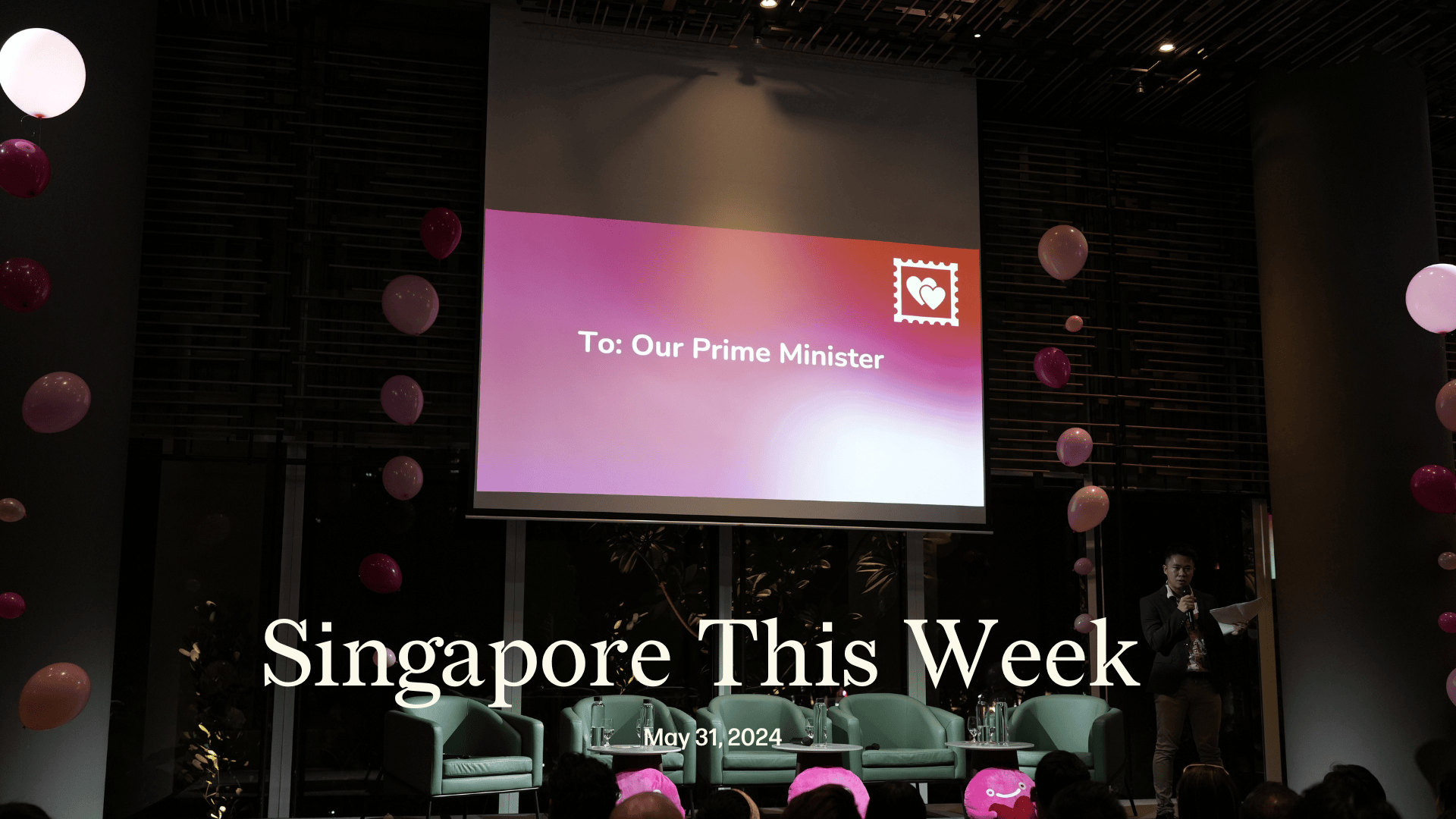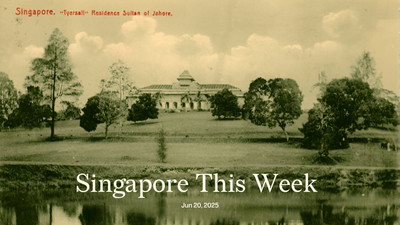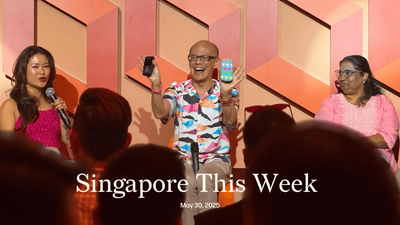Society: A baptism of Pink for Lawrence
In the big tent that Lawrence Wong, Singapore’s new prime minister, claims to be pitching, how much space will there be for our LGBTQ+ community? Wong’s signature Forward SG campaign is centred around the desire to build a “more caring and inclusive society”. And yet, in its almost 180-page report, the product of conversations with 200,000 Singaporeans, there isn’t a single mention of the LGBTQ+ community. This glaring omission will be met with a wave of pink love on June 29th at Hong Lim Park, when Pink Dot, Singapore’s de-facto pride parade and a glittery example of activism in this nanny state, celebrates its 16th edition. The organising committee has called on participants—as many as 30,000 in recent years—to write personal messages to Wong, “to share their hopes for a more inclusive Singapore for LGBTQ+ people.” Come July, Wong should give his guitar and film crew a break in order to read them.
Because the harsh reality is that, some 18 months after Singapore repealed S377A, the law criminalising sex between men, the lives of queer people have not materially improved. This year’s edition will thus more broadly focus on the continued marginalisation and discrimination that the community faces. Wednesday’s launch party was a potpourri of hugs, pink cocktails, and searing testimonies. Bhuvan Daniel described the challenges of transitioning as a South Asian person, and in a complex school environment as a teenager. Shunned by many around him and short of money, he had to constantly look for new friends: “Being 16 and having to pay for things yourself. What do you do?” Shania Saudah Yusof talked about how transitioning affected her housing and job security. “Some of them [her friends] end up de-transitioning just because they need to fit in somewhere.” Charles Ho spoke about the anxieties that older LGBTQ+ people face, including the fear of dying alone. “The overwhelming sense of loneliness is what keeps creeping up in our support groups.” Because queer Singaporeans are often the unmarried ones in the family, the burden of caregiving for elderly parents frequently falls on them. And, given the typically gendered nature of the role, says Ho, it’s lesbians who have it worst.
Wong, Singapore’s first Christian prime minister, expressed his support for “family-centred policies” in 2022. But how will that square with his calls for inclusiveness in a secular nation? To be clear, he must insist on the separation of church and state. Singapore is already several decades late in enshrining rights for our LGBTQ+ community, and the pitiful state of affairs was encapsulated by a tender classroom conversation. “Cher, is it OK if I fall in love with another girl?” one female student had asked Shania, then a teacher. “What do you think?” responded Shania, gently. The student's answer: “It’s OK. But it’s also not OK.”
Note: Attend Pink Dot at Hong Lim Park from 3.30pm on June 29th. Watch the first of three campaign videos. Consider being an individual or corporate sponsor.
Some further reading: In “The repeal of S377A: democracy, secularism, and acceptable speech under threat”, Jom described the problematic parliamentary proceedings, in which both the ruling People’s Action Party (PAP) and the opposition Workers’ Party allowed their members of parliament to validate anti-gay sentiments.
Society: A nation rallies around our Bangladeshi brother
While the queer community waits on him, Wong this week tried to help a prominent member of another vulnerable community—but all to no avail, sadly. Despite his appeal through the new prime minister for an immigration extension, MD Sharif Uddin, a Bangladeshi, was forced to leave Singapore this morning.
In the 16 years that he’d been here, Sharif made a name for himself as a talented poet and a fearless advocate for workers’ rights. At the 2018 Singapore Book Awards, he became the first migrant worker to win the prize for Best Non-Fiction Work, for Stranger to Myself: Diary of a Bangladeshi in Singapore. His troubles began in March, when he was fired from his job as a safety coordinator, the culmination of nearly two months of his employer being harassed by supposed debt collectors both at the office and at home. On Tuesday, the Singapore Police Force (SPF) and the Ministry of Manpower (MOM) released a joint statement saying that its “extensive investigations” have found no evidence that Sharif borrowed money. SPF was also unable to identify the alleged harasser. Since March, Sharif had been unable to find new employment under the Temporary Jobs Scheme. Without a job, he can’t stay. The authorities had given him until Saturday to leave.
Over the past week, Singapore’s independent and mainstream media have written extensively about this case. On Wednesday evening, Sharif and friends went to Wong’s weekly meet-the-people session, which is near his dormitory at Old Choa Chu Kang Road. Only residents and citizens are allowed, so Sharif had to wait outside. He wrote: “Of all the residents waiting to see him, they [Sharif’s friends] were given the first appointment. After hearing my friends out, the PM immediately said he will write a letter to ICA [Immigration and Checkpoints Authority] the same night, asking them to extend my stay in Singapore so I am able to find a job.”
Early this morning, ICA and MOM said they had reviewed the appeal but their position hadn’t changed. They added that Sharif had apparently been offered jobs as a “packer” and “hotel cleaner”. Some might interpret this as showing the limits of the new prime minister’s powers; others as demonstrating the independence of institutions. Sharif caught an early flight out today. Singapore has lost a gem. We hope he returns one day.
Society: Siddharth captures the GM castle
Singaporean teenager Siddharth Jagadeesh is the latest entrant to the rarefied chess grandmaster (GM) club after beating Andrey Esipenko at the Sharjah Masters tournament. Esipenko is a “super-grandmaster”, an informal term for players whose Elo rating–the sport’s storied ranking system—is more than 2,700. Currently, there are only 36 super-Grandmasters on the planet, so Siddharth’s win was no mean feat.
Could Singapore chess be on the cusp of a golden age? In 2020, Kevin Goh became our first grandmaster in more than two decades; in February this year, eight-year-old Ashwath Kaushik, an Indian citizen who moved here in 2017 and plays under the Singapore flag, became the youngest player ever to beat a grandmaster in classical chess. Goh, who also heads the Singapore Chess Federation (SCF), recently revealed that SCF is keen to host the World Chess Championship between India’s Gukesh Dommaraju and China’s Ding Liren later this year. If the federation succeeds, it will be yet another fillip to a sport which is already gaining traction thanks to our players’ exploits and the breathtaking success of “The Queen’s Gambit”, a Netflix series.
While the decades before this may have been fallow, local chess tradition goes back at least to 1896, and the founding of the Singapore Chess Club. Records indicate that another Goh (Keng Swee) was one of the colony’s strongest players in the immediate aftermath of the Japanese occupation. Thanks to him, one of the most momentous events in the history of modern Singapore is rife with chess imagery.
In a parliamentary speech on July 20th 1961, the future deputy prime minister declaimed: “Some [players] again are bold to the point of recklessness so that they readily embark on what chess players call speculative moves…And so it is that this man has initiated on the political chess board moves which I can only describe as speculative in the extreme, the consequences of which to himself and to his country he has not properly calculated.”
This man was Dr Lee Siew Choh, a fellow chess aficionado. Indeed, their friendship had been formed over the chessboard and it was via the game’s argot that it fell apart. Days later, Lee left the PAP to form the Berisan Socialis alongside Lim Chin Siong and others. It is fitting then that chess is making waves again in a year when Singapore’s most consequential general election since the 1960s could be held. (It’s due by November 2025.) The game is indeed afoot.
Society: ‘Palestine, we see you’
The clip of Shruti Kumar, graduating senior, condemning Harvard University’s treatment of pro-Palestine students during her commencement speech, went viral last week. Yet just as meaningful, in our little red dot, was the valedictorian speech two weeks ago by Nageen Rameez, graduating senior at Yale-NUS College (YNC). “To the families in Gaza who have met a much much more violent loss of home and community—for us to witness your suffering from such a close vantage point in our final year of college puts everything we have learnt to the test. We are graduating today, but there are no more universities left in Gaza.”
Rameez was one of 43 students, some 20 percent of the graduating cohort, who expressed solidarity with the Palestinians by wearing red-black-green wristbands, keffiyehs, and through their actions and words on stage. “Palestine, we see you,” Rameez concluded. “And we will continue showing up for you. Because that is what we do.”
Kudos.
Earth: Big oil, bigger doubts
“Greenwashing” and “highly concerning” are what students from Nanyang Technological University (NTU) have called a S$60m partnership between the university, the Agency for Science, Technology and Research (A*STAR), energy giant ExxonMobil, and the National Research Foundation to set up a corporate lab to develop lower-emissions technologies. The “ExxonMobil-NTU-A*STAR Corporate Lab” aims to advance global research efforts in five areas, including converting biomass into lower greenhouse gas emission fuels. Speaking at the launch of the first corporate lab by an energy major, Heng Swee Keat, deputy prime minister and coordinating minister for economic policies, said that such laboratories bring public and industry researchers together “to tackle shared challenges”.
But student-led group NTUDivest said that given ExxonMobil’s “current and past environmental track record worldwide”, it was “extremely doubtful” that Singapore’s clean energy transition should be “so heavily funded and influenced” by one of the “most notorious mega” oil and gas companies. Major fossil fuel producers contribute significantly to global greenhouse gas emissions and hence play a huge role in driving the climate crisis. Given ExxonMobil’s reputation (even among its peers) and environmental missteps (like the Exxon Valdez oil spill in 1989), it’s not hard to understand the group’s scepticism. Adding fuel to the fire, leading oil companies, like Exxon, have reportedly known about the impact of climate change and the dangers posed by fossil fuels since at least the 1970s. But instead of mitigating the effects of what the science was telling them, it went to great lengths to mislead and confuse the public, embarking on a decades-long campaign “to downplay or discredit what its own scientists had confirmed.” And while it has denied these allegations, last month, US democrats found in subpoenaed company documents that firms like Exxon, BP and Shell have lobbied against climate laws and regulations they outwardly supported, while pledging to back international climate efforts that were in truth incompatible with internal climate plans.
NTUDivest, part of an inter-university movement Students for a Fossil Free Future, advocates for the university to cut investments in the fossil fuel industry. It told TODAY that such collaborations are “greenwashing efforts that endanger our collective futures,” and asked for more student involvement and greater transparency on how the lab’s new technologies will align with Singapore’s net zero ambitions. What independent academic institutions can do better is practise rigorous due diligence that tempers any enthusiasm to jump into bed with well-funded corporations. If they can’t convince the public, who else can?
History Weekly by Faris Joraimi
We now have a third sculpture of British empire-builder Stamford Raffles, recently unveiled by NParks at the site of Singapore’s first botanical garden in Fort Canning Hill. He appears not in triumphant solitude, but leisurely conversing with a companion, the Danish naturalist Nathaniel Wallich, who was superintendent of the Royal Botanic Garden in Calcutta, India. Andrew Lacey, the British sculptor commissioned to make the artwork, was inspired by the two men’s collegial friendship over a shared love for botany. What a privilege that our dear green place was made by the provident and gentle hand of such bookish romantics, who had nothing at all to do with colonial racism, extraction and conquest. From the waist down, Raffles and Wallich are shown transforming into vines and leaves, while their bronze surfaces are meant to age with time and “meld into the background”. A fitting illustration of how colonial histories, biases, and structures are so normalised in our country that they become invisible.
There’s a long history of under-acknowledged local labour in Malayan scientific research, captured in the relationship between the naturalist Alfred Wallace and his assistant Ali, a Malay youth from Sarawak. A sculpture of them outside the Lee Kong Chian Natural History Museum (LKCNHM) shows Wallace pointing to a bird and Ali gingerly crouched over a rifle—a likely reversal of their real-life roles. Contemporary art has worked with this incomplete record on Ali, such as “Portrait No. 3” from Fyerool Darma’s “Moyang” series. By sheer coincidence, a day after the Lacey sculptures were unveiled, the LKCNHM’s Instagram account uploaded a list of animals in Singapore’s first public zoo in 1875, then part of the botanic gardens which stands today (the first gardens ran out of funds after nine years). One of them, a two-horned Sumatran rhinoceros, was a gift from Datuk Kelana Abdul Rahman, ruler of Sungai Ujong, one of Negeri Sembilan’s nine traditional domains. Today a state of Malaysia, Negeri Sembilan’s cultural kinship with the Minangkabau highlands of west Sumatra makes it less surprising that they procured a Sumatran rhino from its habitat and presented it to the zoo through Andrew Clarke, then-governor of the Straits Settlements. Abdul Rahman had signed a treaty accepting British “protection” of his territory just the year before.
Arts: Smile, you’re on Caméra d’Or
Chiang Wei Liang, a Singaporean director, has received a rare “special mention” in the main Caméra d’Or (“Golden Camera”) category at the 2024 Cannes Film Festival for “Mongrel”. His debut feature film, praised by the jury for its “exceptional quality”, follows an undocumented Thai migrant to Taiwan, where his deep compassion catalyses his tireless caregiving work with the disabled and elderly, but also makes him susceptible to exploitation by his callous employer. Chiang, based in Taiwan for the past decade, has long focused on the migratory journeys of the South-east Asian diaspora. His award-winning short film “Anchorage Prohibited” (2015), also set in Taiwan, accompanies a pair of Vietnamese labour immigrants and their child as they wander the fringes of Taoyuan. “Luzon” (2017) alludes to choppy geopolitical waters and maritime conflict through an encounter between two fishermen from Taiwan and the Philippines—and a nuclear waste barrel from China.
This isn’t the first time the Caméra d’Or has set its sights on Singaporean film. Anthony Chen’s tender family drama “Ilo Ilo” (2013), which also centres a migrant worker’s story, was the first Singaporean film to win the award at the prestigious festival. Recent Singaporean representation at Cannes has been encouraging, including Chen’s “The Breaking Ice” (which Jom reviewed). There’s also been a trend of cinematic partnerships with Vietnam: last year, the meditative “Inside The Yellow Cocoon Shell”, a Vietnam-Singapore-France-Spain co-production, also received the Caméra d’Or; this year, the Singapore co-produced and co-funded “Viet And Nam” was screened in the festival’s Un Certain Regard section, which celebrates more experimental approaches to style and narrative. Singaporean films on the contemporary awards circuit have been particularly attentive to the precarious routes that migrants take across the city-state’s terrestrial and maritime landscapes. In Yeo Siew Hua’s feted “A Land Imagined” (2018), a Chinese construction worker’s disappearance prompts a police investigation, but also invites us to interrogate our relationship with land reclamation. Kirsten Tan’s “Dahdi” (2015) imagines what a conflicted Singaporean might do when confronted with the arrival of a Rohingya refugee. Like Chiang, they’re sensitive to transient labour rendered invisible, or disposable. The Caméra d’Or also serves to spur the filmmaker’s sophomore effort, so let’s hope that goal is in Chiang’s viewfinder. “Some members of the public have come up to me in the last few days to tell me that they have the same job as [the “Mongrel’s”] protagonist,” he told reporters. “The actors have also been praised in the street for their performance...We’re extremely happy about that.”
Arts: ’Tis the Season to be Children
School’s out, and museums are in! That seems to be the verdict from the first-ever panel of 15 kids who helped curate the signature programmes for the ongoing Children’s Season. The eight- to 12-year-olds reviewed shortlisted works and decided on four of them, including an interactive theatre experience set in 1946 at the Former Ford Factory, where participants will face tough choices over food waste; and a pirate adventure at the Singapore Maritime Gallery that also doubles as an introduction to the country’s maritime history. The annual kids’ festival runs till June 23rd across more than 20 museums, galleries and heritage centres nationwide and coincides, of course, with the mid-year school holidays. The Children’s Panel will also try its hand at running the festival through a mini front-of-house “takeover” at some of the museums. Giving children the autonomy to decide on the kinds of arts and culture events they want to experience is the remit of both festival organiser Children’s Museum Singapore (CMSG), the country’s first museum dedicated to children, as well as its collaborator The Artground, the first multi-disciplinary children’s arts centre here. The CMSG took over the Coleman Street premises of the former Singapore Philatelic Museum (site of many a “learning journey” for 80s and 90s kids) when it opened in 2022.
Museum visitorship has been on the rise in Singapore, Covid-19 notwithstanding, in the decade since free admission was introduced for Singaporeans and permanent residents to the National Heritage Board’s (NHB) museums. While the 2023 Singapore Cultural Statistics report is not yet available online, the 2022 report shows that in-person visitorship to national museums and heritage institutions is slowly increasing, from about 2.1m in 2020 to 2.25m in 2021. Considering that visitorship peaked in pre-pandemic 2019 at about 5.78m, the arts and heritage sector is still very much in post-pandemic recovery—and accessible, family-friendly programming doesn’t hurt. When it comes to hands-on involvement and curation by kids for kids, NHB has also just published its first-ever Youth Heritage Blueprint, a set of findings gathered by a panel of 36 young people who conducted dialogues, surveys, and focus group discussions with more than 1,000 peers over one-and-a-half years. They compiled recommendations around museum and heritage accessibility, programming and marketing, including, as one youth put it, “funny irreverent content that doesn’t sound too government-centric”. Seems like learning journeys can be fun, so long as they prioritise pedagogy over propaganda.
Tech: This week in Singapore AI
Singapore’s artificial intelligence (AI) landscape is experiencing a significant boost through strategic partnerships and initiatives aimed at fostering innovation and growth in the sector. For instance, Grab’s collaboration with OpenAI to deploy AI solutions within its ecosystem leverages AI technology to enhance user experiences and operational efficiency in large homegrown technology companies. By incorporating AI-powered tools for accessibility and customer service, Grab is addressing the needs of diverse user groups and streamlining its service offerings. For younger start-ups, the Ignition AI Accelerator, a joint venture by Tribe, Digital Industry Singapore, and Nvidia, signifies Singapore’s commitment to nurture budding AI start-ups and to catalyse the development of a robust AI ecosystem in South-east Asia. This initiative, coupled with support from Nvidia and funding opportunities through Startup SG Tech, will provide start-ups with the necessary resources and expertise to thrive in the competitive AI landscape. As Singapore builds its own large language model (LLM), it continues to attract support from companies such as IBM. By enhancing the SEA-LION LLM and integrating AI governance practices, these collaborations hope to advance AI capabilities and promote responsible AI usage in line with evolving regulatory frameworks.
Tech: Singapore doubles down on a quantum future
At the recent Asia Tech x Singapore 2024 event, Heng Swee Keat, deputy prime minister and coordinating minister for economic policies, said Singapore would plough S$300m into its National Quantum Strategy (NQS) over the next five years. The announcement showcases the country’s strategic focus on advancing various fields of deep technology beyond AI. An integral component of the NQS is the elevation of the Centre for Quantum Technologies at the National University of Singapore. It will facilitate advancements in quantum research across the universities and with A*STAR. Furthermore, the new National Quantum Scholarships Scheme, funding PhD and Master’s level scholars, highlights Singapore’s commitment to nurturing a skilled quantum workforce and fostering strong industry partnerships. To date, there are around 200 quantum researchers and 150 PhD candidates in the field here. Several of them have gone on to launch well-funded quantum software development tools start-ups. This includes: Entropica Labs, which is focused on error correction and fault tolerance, and Horizon Computing Labs, which aims to create quantum applications with classical languages.
In parallel, the announcement of the Green Data Centre Roadmap underscores Singapore’s dedication to sustainability by enhancing data centre efficiency through the integration of 300MW of green energy capacity. This initiative, a collaboration between various companies, aims to promote sustainable development and improve energy efficiency at hardware and software levels for a greener technological ecosystem. Singapore’s strategic initiatives towards deeptech, such as co-investments in start-ups and partnerships with leading universities through programmes like the one launched by Temasek, underscore the nation’s proactive approach in positioning itself as a global leader in quantum and deeptech sectors.
If you enjoy Jom’s work, do get a paid subscription today to support independent journalism in Singapore.








